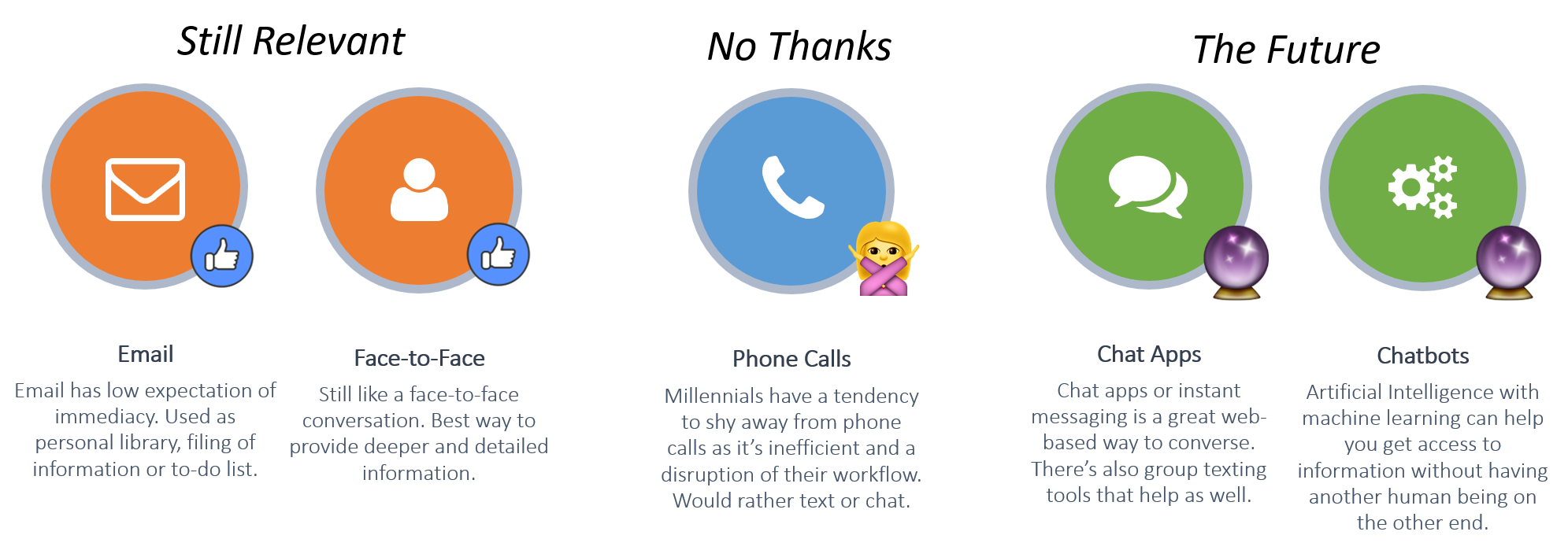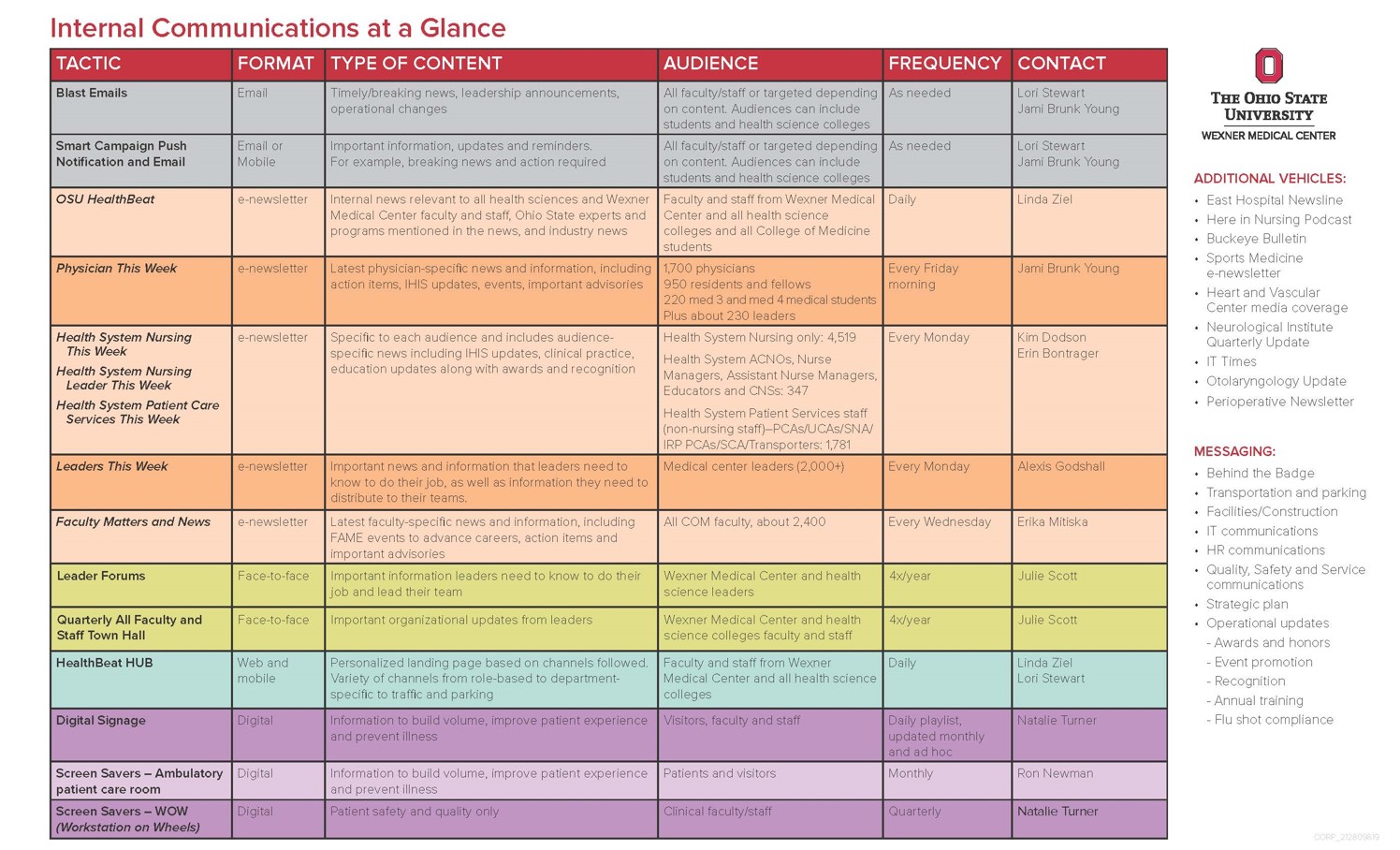COMMUNICATIONS
Wexner Medical Center Overhauls its Internal Communication Strategy to Treat Employee Contact with Same Rigor as External Campaigns
The Ohio State-affiliated academic medical center has compiled a detailed channel mix to help harmonize messaging and onboard new communicators.
COVID-19 has magnified the importance of internal communication, as hospital leaders navigate furloughs, burnout, evolving safety protocols and telecommuting. One Midwest academic provider, however, has quickly mastered this challenge by using consumer segmentation strategies to dissect team members’ communication tendencies.
Years before the pandemic, Ohio State Wexner Medical Center had been conducting employee surveys every two years to understand how individuals consume information. As part of the process, communicators with the Columbus-based provider worked with human resources to pull together demographic data and create “personas” of staff members.
The idea, said Senior Director of Public Relations Julie Scott, was to view internal communications through the same lens as external marketing. She and colleagues wanted to act as if they were going to run an ad campaign for their own employees and needed to know where to target dollars.
“I would argue that it really shouldn’t be any different on the internal side,” said Scott.
Wexner Medical Center crafted eight personas, covering employee segments such as allied medical professionals, nursing and physicians. Each feature detailed demographic data, including gender, full- or part-time status, age, years of service, education, race and business unit.
Some of the findings were unexpected. For instance, nearly half of physicians and staff were under age 35, much younger than hospital leaders expected.
“That was a real surprise to us,” Scott said. “Health care tends to be a younger audience in a lot of our organization, and so we realized we needed to step back and understand that.”
Consumption Preferences
As part of the process, Wexner Medical Center built profiles of each employee group and their information-consumption habits outside the office, among other details. For instance, nurse Naomi, age 26: doesn’t own a landline, has a 20-minute commute to work via neighborhood roads, and prefers Facebook, Pinterest and Instagram, spending two hours per day. She’s also single, has three roommates, loves yoga and gets her news from ABC or the local newspaper. Allied health professional Alice, age 32, on the other hand, is married with one child, favors radio and cable news, and enjoys gardening.
Scott and colleagues started to use some of these habits to build an internal communication strategy that fit their workforce.
“Some might ask: Does that really translate into internal communication? And the short answer is yes, of course it does,” Scott said. “We don’t ask our staff and our physicians to drop their preferences when they walk through the work door. We’ve asked ourselves how we can meet people where they are with communication and what it means if we can do that.”
While most employers think their workers leave over money, Scott noted that in reality, research shows that it’s less than 20% (according to a Gallup poll). Rather, workers leave a job for myriad reasons, such as their experience in the company, coworkers, managers and environment. Wexner Medical Center believes internal communication is crucial to keeping employees intertwined with mission, vision and values.
“We know that employees who feel connected to the organization do a better job of representing that organization to its customers,” Scott said. “There’s never been a time when the ‘employee experience’ buzzword is more on the minds of your human resources chief and CEO, but really it’s been a part of internal communications all along.”
Channel Surfing
After unearthing the revelation of Wexner Medical Center physicians’ ages, leaders decided to start with the 35-year-old segment to start overhauling in-house communication. However, Scott and colleagues quickly realized that today’s “modern employee” is not defined by age, with many taking on youthful characteristics in their information consumption.
Few individuals, if any, receive their daily news from just the paper or evening news. Instead, they found employees from age 35 to 70 gather intelligence from many sources — websites, social channels, radio, conversations, instant messaging and video. Wexner built channels to target employees in different ways, with varying types of information. Digital was placed at the center and the intranet served as the hub, utilizing a mobile-first mindset.
“We need to be able to communicate in ways that people can get on the move,” Scott said. “We had already been discussing this idea but the pandemic and sending people home or to far-flung work sites really sped this process up for us.”
Scott broke down eight communication channels, all used by Wexner Medical Center in varying capacities and liked by employees, to differing degrees. She emphasized the importance of seamless transitions between these conversations and using each method efficiently.

Love
Texting: The preferred form of communication for short, quick exchanges and an excellent way to push a notice with a link. High immediate reaction.
Mobile apps: More responsive than emails and also a “big favorite.” Effective for navigating through information, but different from a responsive website.
Web portals: Likely your best bet for deeper information and knowledge.
Internal social media: Employees’ love of these platforms extends into the workplace. Team members use them to share info, recognize others and pose questions to peers.
Like
Email: Has a low expectation of immediacy and typically used as a personal library, filing cabinet for information or to-do list.
Face to face: Employees still appreciate in-person conversation, often the ideal way to provide deeper, more detailed information.
No thanks
Phone calls: Millennials seem to shy away from this channel, seeing it as inefficient and disruptive to their workflow. Text or web chat are preferred.
The future
Chat apps: Instant messaging or chat functions are a useful way to converse with employees, while new group-texting tools are also promising.
Chatbots: Artificial intelligence and machine learning can help employees access information without human on the other end of the conversation.
Wexner Medical Center has also compiled a “sample channel mix” to aid in this process. The color-coded table details the tactic used (i.e., a blast email), format, type of content, audience, frequency and point-person in charge of it. This is shared with all new leaders and members of the public relations department so they can quickly grasp the organization’s communication vehicles — who gets them and when.

“This helps us as we on-board new communicators and determine where we might have gaps and can go back to refer to this channel mix,” Scott said.
This article features interviews with:
Julie Scott
Senior Director, Public Relations
Ohio State University Wexner Medical Center
Columbus, Ohio